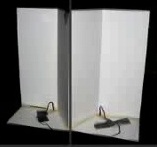T4-10 Styro Head EM158 Omni Mics. A) Perhaps I am being biased because the rig is fitted to a foam head, but, I think this rig does an excellence job of recreating localization for the human head. When I close my eyes, without looking at the graphic, each clink has a physical presence in my ears and is easily mapped out. Because the capsules are front facing they seem to favor 10-2 o’clock, which makes it harder for me to discern he location of these because the clinks seem pushed against you, whereas the 8,9,3,4 positions have a lot of space behind them allowing for more reverberation and imaging.
B) The clinks sound further away at 8, 3, and 4. And closer at 9, 10, and 11. At 12 the rig seems to have the correct depth. This is perhaps due to the 6” headspace on the foam head allowing the stereo image of the sound to reach both ears properly. At the other positions the opposite capsule becomes a victim of head shadow, something the human head experiences, which causes one ear/capsule to receive more sound sooner than the opposite one. However, one problem with this rig is that the human ears are actually A-B positioned, while the capsules are front facing.
C) This rig does an excellent job of mapping out the architecture of the space. When I listen to this I can pretty much visualize where every wall was. I know that 8 sounds much further away because there is a lot of dead space behind that area, with a wall much further from the “clinker” than any other position. From 9-12 there is a wall directly behind the clinker, 9 sounds like it is further from this wall though, and 11 sounds very sharp, like the clinker was standing in corner with all the sound being collected and focused before being bounced back. This person was also standing near the car which could have being reflecting a lot of sound. 12 o’clock sounds perfect. The capsules are facing forward and the clinker is in front of a large wall, so the sound is thrown right back. 1-4 positions mimic the 8-11, but with less volume, perhaps because the clinkers used less force, or because there was more space, particularly at 3 where there was a huge depression in the room where the loading dock was, this clink seems to travel for a while, perhaps the longest on this rig.
T6-14 Psuedo-SASS – 110 degrees EM158 Omni Mics 6” separation, Inset 2.5”A) When compared to the Styro Head, this rig seems to have a less accurate localization. First of all, everything sounds somehow compressed and too immediate, while the styro head rig has much more room in it and picks up more reverberation. Also, at the 10-2 positions the space between the two angles on the SASS is felt. It seems to create a physical space between the two capsules.
B) The only position that seems to get a lot of depth with this rig is the 3 o’clock, which I am assuming will be the same for all tests because of the loading dock behind that position. Otherwise, everything else seems compressed, as if the clinks are half the distance from the rig. Perhaps this is what I was getting at with the localization; everything seems closer, so the clock positions seem accurate in that respect.
C) This rig does not seem to create an accurate picture of the space. The only position it somewhat recreates is the 3 o’clock. The differences in space and volume are subtler than the styro head creates. Again, this is because the SASS causes the clinks to have more volume and immediacy. This seems to compress the space and begins to make it sound like a perfectly square room with no impeding objects or depressions, except at the 3 position.
* I realize that this entry makes it seem as though I did not like the rig, however, I think it could be useful for compressing a space and getting more gain from a spacey area, which is why I chose it.
T5-3 Parallel Boundary Rig 1.5” Inset EM158 Mics. A) This one sounds very similar to the styro head. As opposed to the SASS, this rig gives the clinks more space and a more realistic image of the clock positions. Although this rig seems mimic the human head (6” spacing), it does not create the “head shadow” stereo image that the stryo does. For example, sound from 9 seems to wrap around and reach the opposing capsule. Whereas the stryo creates a shadow to separate 9 from 3.
B) Although this rig has more depth than the SASS, it definitely has less than the stryo. In fact, the 3 position seems to have lost its depth from the loading dock space. This could be because the clinker may have clinked too hard or too sharply, because 8 and 9 still seem to have accurate depth.
C) Except for the 3 position this rig seems to draw the space accurately. Although it does have that slight “compressed” feel I mentioned in regards to the SASS, it has a much more accurate depth and localization. This seems particularly true at 9 and 8, the large space behind those clinkers is felt. The clinker at 9 sound like he is standing at the line where the closer wall and the car is. Half the clink seems to roll into the empty space where 8 is standing, and half seems to be reelected off of the closer wall where 10 is standing.



